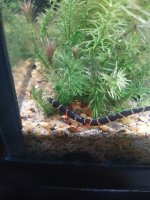Hi All,
Back again for some more advice. I bought 8 Kuhli loaches about 2 weeks ago for my 60L tank. The tank has sand + fine gravel. One of them has a mark that I'm a bit worried about. This is my first tank, 12 weeks in and I don't know that much aboout diseases and treatment.
I noticed 1 week in (last week), that one of the loaches has a slightly different patch on him than the other ones - a paler/whiter area on his back. I only realised it wasn't a normal marking because the others don't have it, but it's bang on the middle of his back so it looks like it could be part of him. Luckily, he's the most bold of the kuhli loaches and is often out in the front so I've taken some photos. He eats normally and acts normally (compared to the other loaches in the tank and videos I've seen online), he eats a lot (probably the most), he does a lot of digging in the sand to eat blackworms, and in general does lots of wriggling through plants, investigating and swimming. I've spent the past week wondering if it's a problem, as I realised none of the other loaches have this mark. I did worry for a few hours last week that he had ich, but then I realised it was just a bit of sand as he had been digging. I thought I'd wait and observe to see if it got worse, as I thought maybe it could be a scratch or something from when he was caught at the shop (the bloke took a while and seemed to find it difficult to catch them).
Tonight it looked to me like it may have spread slightly on one side. Annoyingly, as soon as I took my camera out he swapped sides so I've just got photos of one side and top. I'm worried it could be columnaris, but I thought that spreads quicker (he's been this way for a week) - though I just read that it often starts on the back so now I'm rather worried. None of the other fish have any marks, or have been acting weirdly. I have the kuhlis, as well as 6 otos and some amano and cherry shrimp, I'm not sure if/how I should treat the tank as I know they're very sensitive to medication. I do a 50% water change weekly.
He's my most bold loach, and I'd really like to make sure he's ok. Please help!
Back again for some more advice. I bought 8 Kuhli loaches about 2 weeks ago for my 60L tank. The tank has sand + fine gravel. One of them has a mark that I'm a bit worried about. This is my first tank, 12 weeks in and I don't know that much aboout diseases and treatment.
I noticed 1 week in (last week), that one of the loaches has a slightly different patch on him than the other ones - a paler/whiter area on his back. I only realised it wasn't a normal marking because the others don't have it, but it's bang on the middle of his back so it looks like it could be part of him. Luckily, he's the most bold of the kuhli loaches and is often out in the front so I've taken some photos. He eats normally and acts normally (compared to the other loaches in the tank and videos I've seen online), he eats a lot (probably the most), he does a lot of digging in the sand to eat blackworms, and in general does lots of wriggling through plants, investigating and swimming. I've spent the past week wondering if it's a problem, as I realised none of the other loaches have this mark. I did worry for a few hours last week that he had ich, but then I realised it was just a bit of sand as he had been digging. I thought I'd wait and observe to see if it got worse, as I thought maybe it could be a scratch or something from when he was caught at the shop (the bloke took a while and seemed to find it difficult to catch them).
Tonight it looked to me like it may have spread slightly on one side. Annoyingly, as soon as I took my camera out he swapped sides so I've just got photos of one side and top. I'm worried it could be columnaris, but I thought that spreads quicker (he's been this way for a week) - though I just read that it often starts on the back so now I'm rather worried. None of the other fish have any marks, or have been acting weirdly. I have the kuhlis, as well as 6 otos and some amano and cherry shrimp, I'm not sure if/how I should treat the tank as I know they're very sensitive to medication. I do a 50% water change weekly.
He's my most bold loach, and I'd really like to make sure he's ok. Please help!



 )
)